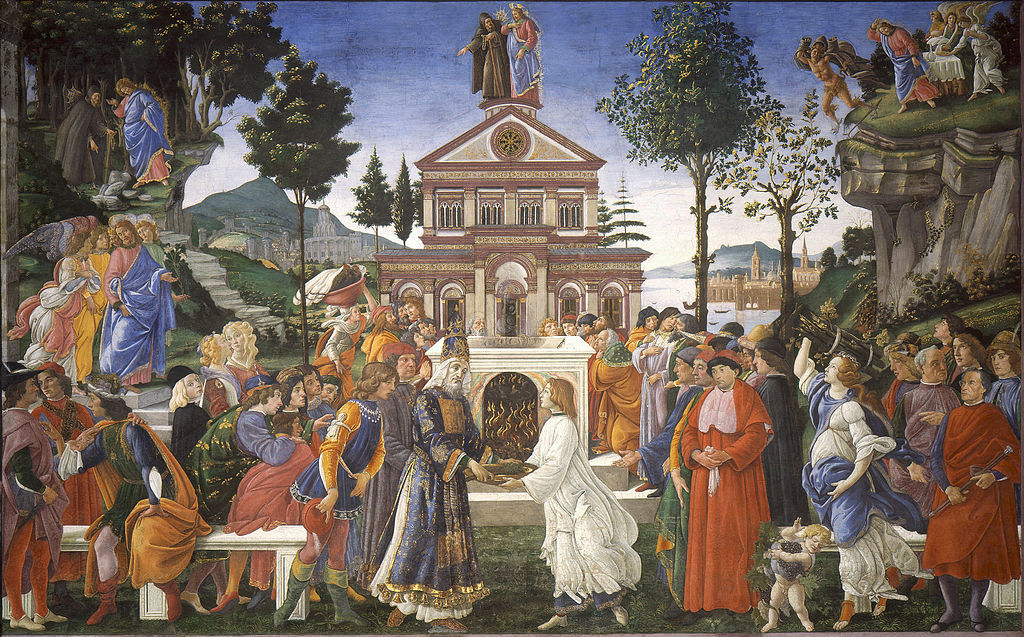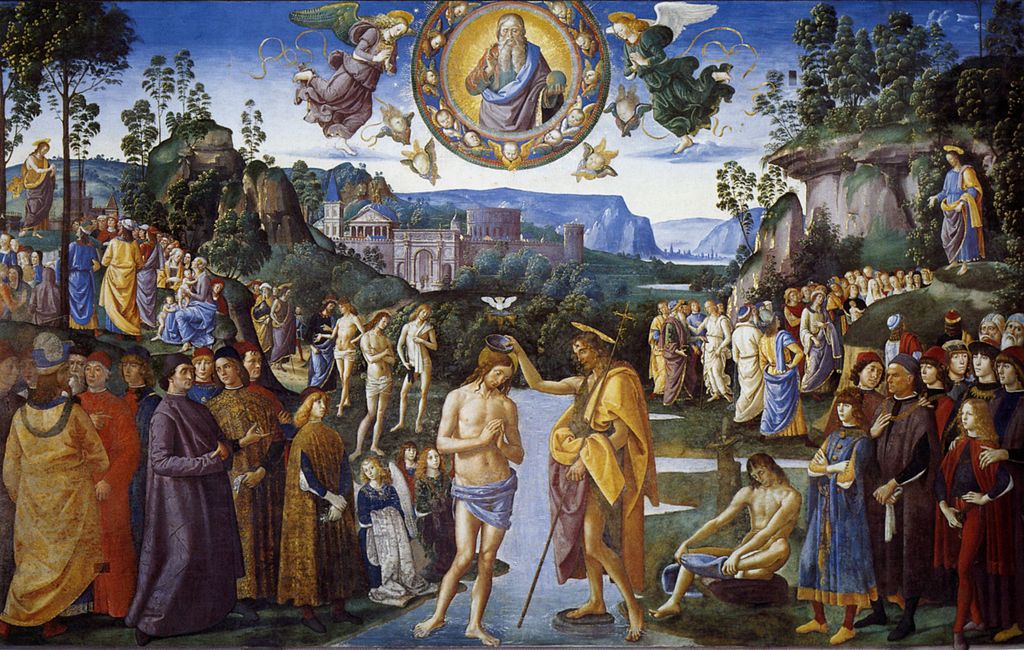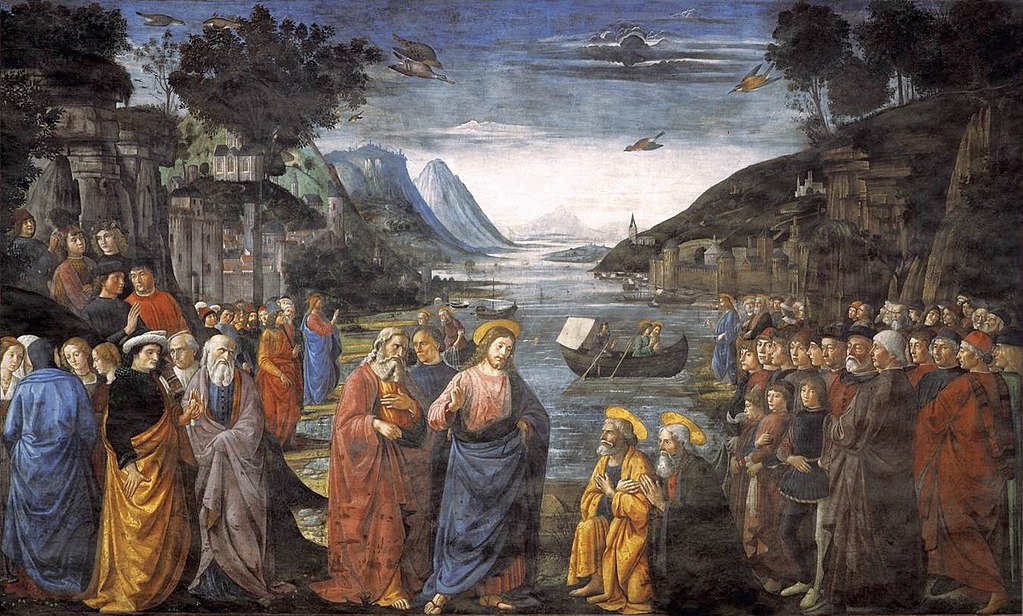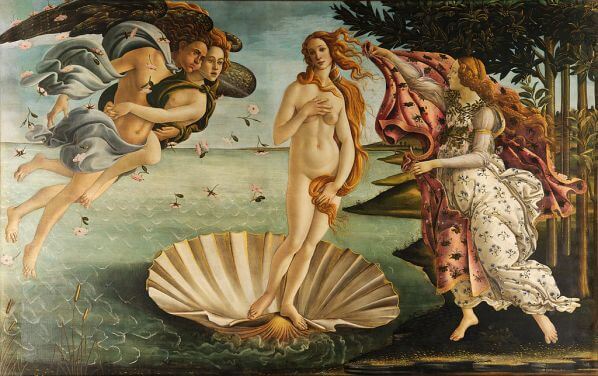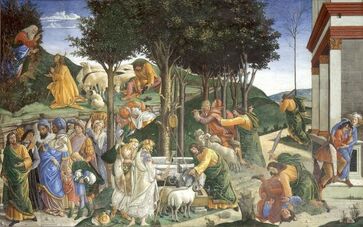|
Where? On the North wall of the Sistine Chapel in the Vatican Museums
When? 1481-1482 Commissioned by? Pope Sixtus IV What do you see? Five different scenes.
Backstory: Matthew 4: 1-11 describes the temptations of Christ. After Jesus was baptized, he went into the desert to think about how he would present himself to the world. He started by not eating for 40 days, and after this period the Devil visited him and tried to tempt him in three ways, as shown in this fresco. Surrounding frescos: The scenes on the North wall of the Sistine Chapel illustrate the life of Christ. These scenes are ordered chronologically. When you face the North wall, the first scene is depicted on the right (immediately next to The Last Judgment by Michelangelo). It illustrates the Baptism of Christ, as described in Matthew 3, and is painted by Perugino. This scene took place right before the temptations of Christ as painted by Botticelli. The third scene illustrates the Vocation of the Apostles by Ghirlandaio. This is what Jesus does right after he resisted the temptations by the Devil and this story is described in Matthew 4.
Symbolism:
Who is Botticelli? Alessandro di Mariano di Vanni Filipepi (1445-1510), better known as Sandro Botticelli, was born in Florence. He painted mainly religious subjects, but also some portraits and mythological subjects. Some of his best-known works include The Birth of Venus and La Primavera, which are both in the Uffizi Museum. In 1481, Pope Sixtus IV asked Botticelli to come to Rome to create some frescos for the Sistine Chapel. Over the next two years, Botticelli painted three frescos in the Sistine Chapel among which the current one, Punishments of the Sons of Corah, and Youth of Moses.
Fun fact: This fresco by Botticelli closely follows the Biblical story as described in the Gospel of Matthew. However, Botticelli made some changes to the story to please the commissioner. For example, the scene on the top left takes place in the desert according to the Bible. Botticelli, however, depicted the first temptation of Christ in front of a forest with oak trees, as the oak tree was the symbol of the Della Rovere family to which Pope Sixtus IV belonged.
Another clear deviation from the Biblical story is the depiction of the Temple. The large building in the middle of this painting is probably a copy of the old St Peter’s Basilica. It serves both as the backdrop to the scene in the middle foreground, where it is supposed to represent the Church, and the scene on the top middle, where it should represent the Temple. Other fun facts: Don’t forget to notice the young boy in the right foreground. He has a bunch of grapes in his hand and tries to keep it away from the small snake that is behind him. Also, to the left of the altar is a woman with a basket with two cocks or hens on top of her head, which are to be sacrificed. Interested in a copy for yourself? Poster or canvas.
Written by Eelco Kappe
References:
0 Comments
Leave a Reply. |
Categories
All
|
- Home
- Blog
-
Museums
- Alte Pinakothek
- Art Institute of Chicago
- Baltimore Museum of Art
- Barber Institute of Fine Arts
- Bargello
- Barnes Foundation
- British Museum
- Church of Sant’Anastasia
- Cleveland Museum of Art
- Courtauld Institute of Art
- Detroit Institute of Arts
- Frans Hals Museum
- Galleria Borghese
- Gallerie dell'Accademia
- Getty Museum
- Guggenheim
- Hermitage Museum
- Kunsthistorisches Museum
- Kunstmuseum Basel
- Legion of Honor Museum
- Louvre
- Mauritshuis
- Metropolitan Museum of Art
- Musee d’Orsay
- Museum of Fine Arts in Boston
- Museum of Modern Art
- National Gallery in London
- National Gallery of Art
- National Museum in Poznań
- Norton Simon Museum
- Ny Carlsberg Glyptotek
- Palace of Versailles
- Palazzo Pitti
- Palazzo Vecchio
- Petit Palais
- Philadelphia Museum of Art
- Prado
- Pushkin Museum
- Ravenna Art Museum
- Rijksmuseum
- San Diego Museum of Art
- Santa Maria delle Grazie
- St. Peter's Basilica
- Städel Museum
- Statens Museum for Kunst
- Tate Britain
- Tate Modern
- Timken Museum of Art
- Uffizi
- Vatican Museums
- Wallace Collection
-
Artists
- Altdorfer
- Anguissola
- Berlin Painter
- Bosch
- Botticelli
- Boucher
- Bronzino
- Bruegel the Elder
- Brunelleschi
- Cabanel
- Caillebotte
- Canova
- Caravaggio
- Carpeaux
- Cezanne
- Cimabue
- David
- Degas
- Delacroix
- De Maria
- Donatello
- El Greco
- Fontana
- Fra Angelico
- Fragonard
- Gauguin
- Gentileschi
- Gericault
- Gonzalez-Torres
- Goya
- Hals
- Hogarth
- Hokusai
- Ingres
- Leonardo da Vinci
- Lippi, Filippo
- Longhi, Barbara
- Lorrain
- Makovsky
- Manet
- Massys
- Matisse
- Merian
- Michelangelo
- Mochi
- Modigliani
- Monet
- Panini
- Parmigianino
- Perugino
- Picasso
- Pisanello
- Raphael
- Rembrandt
- Renoir
- Reynolds
- Rivera
- Rodin
- Rubens
- Scultori
- Seurat
- Steen
- Tintoretto
- Titian
- Toulouse-Lautrec
- Turner
- Uccello
- Van der Weyden
- Van Dyck
- Van Eyck
- Van Gogh
- Van Hemessen
- Vasari
- Velazquez
- Vermeer
- Veronese
- Vigée Le Brun
-
Locations
- Books
- About Us

